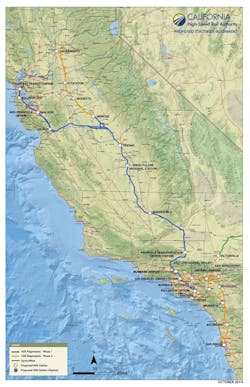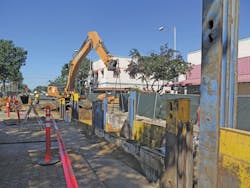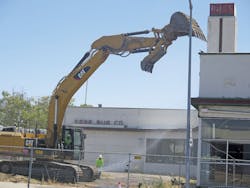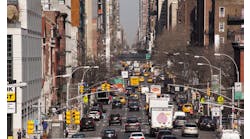By: Frank Vacca
Just about everyone who lives in or visits California must contend with endless traffic jams, flight delays and spotty passenger rail service.
All this wasted time strains the economy. In fact, the Texas Transportation Institute estimated in 2011 that traffic congestion on the state’s outdated roads caused $19 billion in lost economic activity.
Due to the state of our existing transportation infrastructure, there is no doubt of the need for an alternative transportation option. California is the world’s seventh-largest economy, yet the state’s aging infrastructure provides limited opportunities for improvements at great cost to meet future population growth—estimated to hit 50 million in the next 30 years. According to the California Department of Transportation, upgrading the existing airports and freeways to meet future needs would require over 4,300 new highway lane-miles, 115 additional airport gates and four new terminals. Already, the San Francisco Bay Area to Los Angeles area is the busiest short-haul air market in the country. California’s inter-city passenger rail lines also are stretched thin with the three California Amtrak lines—The Pacific Surfliner, Capitol Corridor and San Joaquin Corridor—ranking second, third and fifth, respectively. High-speed rail will fill an important gap in the state’s existing infrastructure and provide a long-term solution that will benefit future generations of Californians.
As part of the construction of the Fresno River viaduct located near the city of Madera in California’s Central Valley, a large rebar cage was fabricated on-site. This cage will be part of the support system for the bridge.
The California High-Speed Rail Authority (Authority) is responsible for planning, designing, building and operating the first high-speed rail system in the nation. High-speed rail will be capable of transporting passengers on an express ride between downtown San Francisco and the Los Angeles/Anaheim area in 2 hours and 40 minutes at speeds more than 200 mph. After this first phase of the system is built, the second phase will add extensions to Sacramento and San Diego, eventually covering over 800 miles with up to 24 stations. When operational, California’s high-speed rail system will link the state’s mega-regions, contribute to economic development and a cleaner environment, create jobs, and preserve agricultural and protected lands.
Central Valley work
Since 2013, the Authority’s first design-build contractor Tutor Perini Zachry/Parsons (TPZP) has been clearing right-of-way and demolishing buildings within the Construction Package 1 (CP 1) area. CP 1 is a 29-mile stretch between Madera and Fresno counties. In June 2015, TPZP started construction of the Fresno River Viaduct, a 1,600-ft aerial structure that will span from Raymond Road to Watson Street in Madera County, crossing over the Fresno River and S.R. 145 parallel to the Burlington Northern Santa Fe (BNSF) tracks.
South of the terminus of CP 1 is Construction Package 2-3 (CP 2-3), the next 65 miles, stretching 1 mile north of the Kern/Tulare county line. In June 2015, the joint venture of Dragados/Flatiron was selected as the design-builder for this section. They have been working to move their staff into the area and will host several community open houses starting this fall. Construction Package 4 (CP4), representing the next 22 miles of the project to just north of the city of Bakersfield, is currently halfway through the design-build contractor procurement process.
When completed, the California High-Speed Rail line will connect the major metropolitan areas between San Francisco, Sacramento, Los Angeles and San Diego.
High-speed rail in the Central Valley is already providing significant job and economic opportunities. The Authority has an aggressive 30% small business participation goal, with 10% directed towards Disadvantaged Business Enterprises (DBE) involvement and 3% directed towards Disabled Veteran Business Enterprises (DVBE) involvement. To date, there are currently 65 small businesses from all over the state doing work on CP 1 with commitments of over $307.5 million. The Authority also is working with local job placement and training organizations in the region to get Valley residents trained on construction-related jobs. They are targeting disadvantaged workers to make sure they have an opportunity to participate in the project.
Environmental concerns
In addition to construction, work continues on the necessary environmental clearances needed in the Bay Area and Southern California to achieve Records of Decision from the Federal Railroad Administration by 2017 to begin construction in those regions.
In addition to construction, the Authority’s design-build contractor for the first construction package, Tutor Perini/Zachry/Parsons, also must relocate existing utilities in partnership with local agencies. In the downtown Fresno area on Kern Street this spring, a section of storm-water drain was relocated in partnership with the city of Fresno and the Fresno Metropolitan Flood Control District.
In northern California, the Authority continues to engage the public and regulatory agencies as it moves toward the planning and environmental process for the San Francisco-to-San Jose and San Jose-to-Merced project sections. The San Francisco to San Jose project section will bring high-speed rail from the Transbay Transit Center currently under construction in downtown San Francisco, through the heart of California’s famed Silicon Valley to downtown San Jose along the existing Caltrain corridor. The Authority is working in partnership with Caltrain to electrify its 51-mile commuter rail corridor from San Francisco to San Jose. The Authority is providing $705 million to support the electrification project and installation of Positive Train Control (PTC) that will allow for the future integration of high-speed rail along the corridor. The San Jose-to-Merced project section is studying two alignments that roughly parallel S.R. 152 with a station in the city of Gilroy that will eventually connect the Bay Area with the Central Valley.
In Southern California, the Authority has held a series of community meetings and advanced planning, preliminary engineering and environmental groundwork to begin the process to select a high-speed rail route from the city of Palmdale to Burbank and eventually to the Los Angeles Union Station and the brand new ARTIC station in Anaheim. Palmdale, a community of over 150,000 people, is located 64 miles outside of Los Angeles. It is a popular place to live for young professionals, but the commute to Los Angeles can be as long as three hours in bumper-to-bumper traffic and two hours via existing rail. Bringing high-speed rail to Palmdale allows residents to get to and from Los Angeles in as little as 30 minutes. Moreover, XpressWest, a privately funded program looking to extend high-speed rail service from Las Vegas to Southern California, has said it wants to make Palmdale its terminus for high-speed rail service. If successful, this service would allow passengers to use California’s high-speed rail service from anywhere in the system to connect to Las Vegas. Environmental documents for the Palmdale-to-Burbank and Burbank-to-Los Angeles project sections are anticipated to be released next year and preliminary studies for the Los Angeles to Anaheim section are underway.
Funding
Funding for high-speed rail has always been envisioned to utilize federal, state and private-sector funding. To date, the Authority has been utilizing $3.3 billion in federal funds (American Recovery and Reinvestment Act) and $4.7 billion in state funds (Proposition 1A). The 2014-2015 California Budget Act, passed by the California Legislature and signed by Gov. Jerry Brown, allocated for the first time a steady funding stream for high-speed rail through the California Air Resources Board’s carbon credit auction (cap and trade). As part of the cap-and-trade program, California holds quarterly sales of allowances to carbon emitters, with proceeds projected to exceed $1 billion annually. The Authority received $250 million for last year and 25% of all future proceeds starting in FY 2015-2016. These proceeds have been a game changer as it is an unprecedented investment in transit and rail that reinforces an integrated approach to passenger rail in California.
In August 2015, the Authority took an important step in reaching out to the private sector with the release of a Request for Expressions of Interest (RFEI). The purpose of the RFEI is to refine the Authority’s delivery strategy of the high-speed rail program through consultation with the industry. Specifically, the Authority is looking for detailed feedback on the technical, commercial, financial and procurement aspects of its preferred delivery strategy, as well as the industry’s view on the potential benefits and challenges from combining large remaining portions of the high-speed rail system into one or more contracts. Through this document, the Authority also is looking for opportunities for cost savings and schedule acceleration, and the key commercial and financial requirements that would be required in order to achieve those objectives.
Modernizing current systems
As part of the high-speed rail program’s overall goal to update and modernize the state’s passenger rail system, the Authority is investing almost $2 billion in connectivity and early investment projects to enhance existing rail services. These programs are designed to improve and modernize existing regional and local rail systems statewide in the near future in preparation to eventually connect with high-speed rail. Two of these are designed as bookend projects as they are located in San Francisco and Los Angeles, the terminus of the first phase of the project. These projects range from electrification projects to PTC, the new locomotives and other upgrades that will allow these systems to integrate and connect with the future high-speed rail system.
The Authority also is currently investing in safety systems that will make all passenger-rail systems throughout the state safer. In 2014, there were over 9,000 accidents in California alone related to grade crossings, where trains and roads cross at the same grade. Over 29 of those accidents resulted in fatalities. Grade separations are a significant hazard to motorists and passengers and also result in wasted time at intersections and traffic back-ups. In the short term, high-speed rail is being constructed in the Central Valley to have no at-grade crossings. Where the system integrates with the existing systems in San Francisco and Los Angeles, existing grade separations will be eventually phased out. In total, the high-speed rail program will eliminate 44 existing grade crossings in the Bay Area, 55 existing freight-rail grade crossings that will be re-routed over or under as part of construction in the Central Valley, and several grade crossings in southern California that have been the site of some of the worst accidents in the region. The Authority also is partnering with local and regional transit agencies to install quad gates at existing crossings, which will block all lanes of traffic on both sides of the track and have been proven to reduce grade crossing accidents by 98%.
To prepare for construction, the Authority’s design-build contractor for the first construction package, Tutor Perini/Zachry/Parsons, must demolish existing structures. The Kerr Rug building in downtown Fresno had been abandoned for many years, and is just one of multiple blighted buildings the high-speed rail program has removed.
The entire high-speed rail system—including the integrated sections—will also feature state-of-the-art train-control systems, including PTC, an advanced signaling system that helps trains avoid collisions. It also functions as an early earthquake-warning detection system with an operational response that includes stopping or slowing of trains. These systems have been proven in countries across the world with high-speed rail systems in seismic areas to prevent accidents and loss of life during earthquakes or other seismic events. In Japan for example, such a system prevented any accidents or fatalities in the high-speed rail system when a major earthquake struck in 2011. There were several trains in operation at the time, and they were all able to stop safely once the system was alerted about the seismic event.
Moving California forward
As we have seen around the world, a reliable high-speed rail system in California will transform the state by connecting the regions like never before.
California’s great Central Valley with its 7 million residents has often been left behind in the state’s economic recovery that has been underway for the last few years. High-speed rail will tie the cities of Merced, Fresno and Bakersfield to the northern and southern economies like never before. As we have seen throughout the world, countries with high-speed rail systems have been able to link suppliers, manufacturers and shippers with their customers and provide new economic and job opportunities. And best of all, we are going to be doing this without adding additional cars to the road or planes in the sky, helping assure that we meet the state’s aggressive greenhouse gas emission goals, while at the same time preserving important land in California and clearing our skies for future generations.
It’s up to us to move this project forward, and today we’re happy to say that we are going full speed ahead. TM&E
About The Author: Vacca is chief program manager for the California High-Speed Rail Authority.






